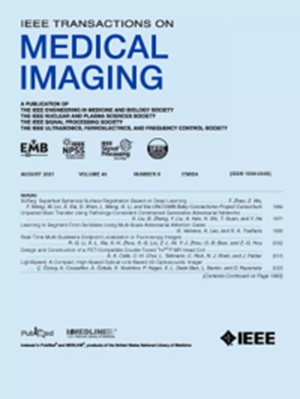一种无监督学习方法在无配对训练数据的情况下从0.3T MRI重建3t样图像。
IF 9.8
1区 医学
Q1 COMPUTER SCIENCE, INTERDISCIPLINARY APPLICATIONS
引用次数: 0
摘要
磁共振成像(MRI)在医学诊断方面具有强大的功能,然而,尽管高场MRI提供了卓越的图像质量,但在采购、安装、维护和操作方面产生了巨大的成本,限制了其可用性和可及性,特别是在低收入和中等收入国家。为了解决这个问题,我们的研究提出了一种基于循环一致生成对抗网络的无监督学习算法。该框架将0.3T低场MRI转换为更高质量的3t样图像,而不需要配对的低场/高场训练数据。该架构集成了两个新的模块,以提高重建质量:(1)关注块,动态平衡高场特征与原始低场输入;(2)边缘块,细化边界细节,提供更精确的结构重建。所提出的生成模型在大规模、未配对的公共数据集上进行训练,并在三个主要临床MRI序列(t1加权、t2加权和流体衰减反转恢复(FLAIR)成像)的配对低场/高场采集上进一步验证。在保持解剖保真度的同时,它显示了组织对比度和信噪比的显着改善。该方法利用了来自公开可用的MRI资源的丰富信息,提供了一种数据高效的无监督替代方案,补充了监督方法,以增强低场MRI的实用性。本文章由计算机程序翻译,如有差异,请以英文原文为准。
An Unsupervised Learning Approach for Reconstructing 3T-Like Images from 0.3T MRI Without Paired Training Data.
Magnetic resonance imaging (MRI) is powerful in medical diagnostics, yet high-field MRI, despite offering superior image quality, incurs significant costs for procurement, installation, maintenance, and operation, restricting its availability and accessibility, especially in low- and middle-income countries. Addressing this, our study proposes an unsupervised learning algorithm based on cycle-consistent generative adversarial networks. This framework transforms 0.3T low-field MRI into higher-quality 3T-like images, bypassing the need for paired low/high-field training data. The proposed architecture integrates two novel modules to enhance reconstruction quality: (1) an attention block that dynamically balances high-field-like features with the original low-field input, and (2) an edge block that refines boundary details, providing more accurate structural reconstruction. The proposed generative model is trained on large-scale, unpaired, public datasets, and further validated on paired low/high-field acquisitions of three major clinical MRI sequences: T1-weighted, T2-weighted, and fluid-attenuated inversion recovery (FLAIR) imaging. It demonstrates notable improvements in tissue contrast and signal-to-noise ratio while preserving anatomical fidelity. This approach utilizes rich information from publicly available MRI resources, providing a data-efficient unsupervised alternative that complements supervised methods to enhance the utility of low-field MRI.
求助全文
通过发布文献求助,成功后即可免费获取论文全文。
去求助
来源期刊

IEEE Transactions on Medical Imaging
医学-成像科学与照相技术
CiteScore
21.80
自引率
5.70%
发文量
637
审稿时长
5.6 months
期刊介绍:
The IEEE Transactions on Medical Imaging (T-MI) is a journal that welcomes the submission of manuscripts focusing on various aspects of medical imaging. The journal encourages the exploration of body structure, morphology, and function through different imaging techniques, including ultrasound, X-rays, magnetic resonance, radionuclides, microwaves, and optical methods. It also promotes contributions related to cell and molecular imaging, as well as all forms of microscopy.
T-MI publishes original research papers that cover a wide range of topics, including but not limited to novel acquisition techniques, medical image processing and analysis, visualization and performance, pattern recognition, machine learning, and other related methods. The journal particularly encourages highly technical studies that offer new perspectives. By emphasizing the unification of medicine, biology, and imaging, T-MI seeks to bridge the gap between instrumentation, hardware, software, mathematics, physics, biology, and medicine by introducing new analysis methods.
While the journal welcomes strong application papers that describe novel methods, it directs papers that focus solely on important applications using medically adopted or well-established methods without significant innovation in methodology to other journals. T-MI is indexed in Pubmed® and Medline®, which are products of the United States National Library of Medicine.
 求助内容:
求助内容: 应助结果提醒方式:
应助结果提醒方式:


